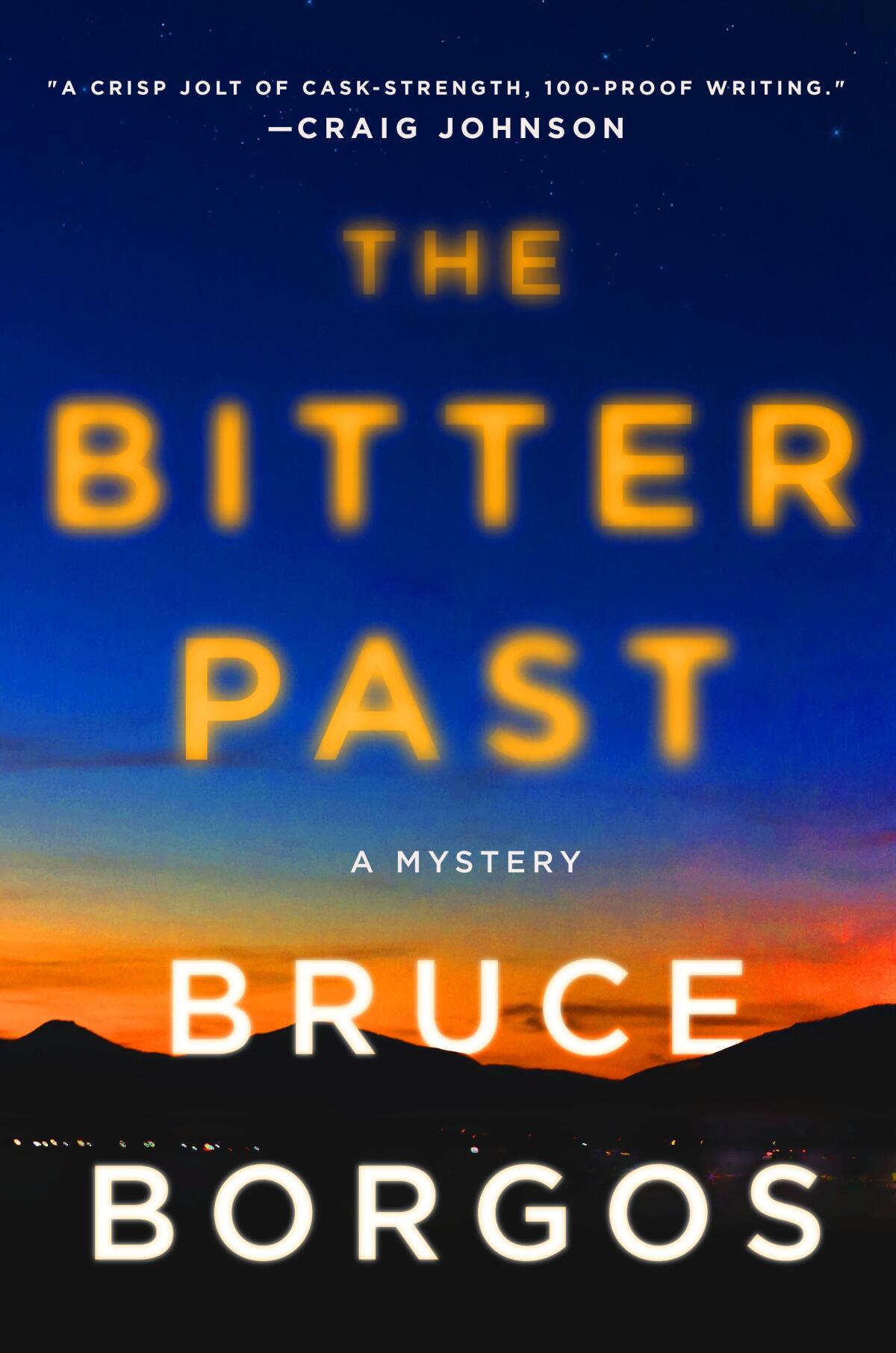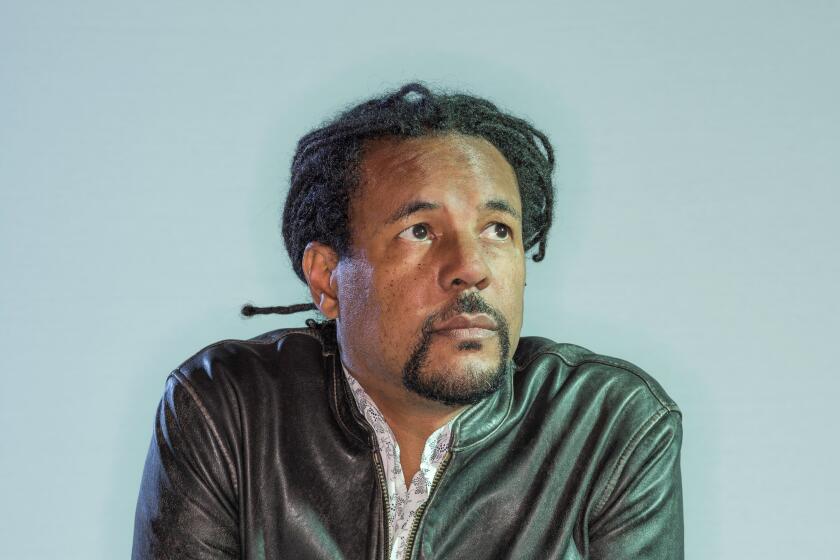The Western thriller book canon expands to Nevada — with a touch of ‘The Americans’

- Share via
Review
The Bitter Past
By Bruce Borgos
Minotaur: 320 pages, $28
If you buy books linked on our site, The Times may earn a commission from Bookshop.org, whose fees support independent bookstores.
When you think of crime fiction series set in the rural American West, Wyoming seems to dominate the field — C.J. Box’s 23 Joe Pickett novels, Craig Johnson’s 19 Walt Longmire mysteries. Close behind is New Mexico, courtesy of 26 Leaphorn/Chee thrillers by Tony Hillerman and (after his death) his daughter, Anne. But that’s just two states, which leaves a lot of open territory ripe for exploration.
Enter Bruce Borgos, whose series debut, “The Bitter Past,” is set north of Las Vegas, in Lincoln County, Nev., “the seventh largest county in the nation, roughly the size of Maryland,” where “neighbors are anyone living within twenty miles.” The county’s sheriff is Porter Beck, a hometown boy who brings to his new job almost 20 years of experience in the Army doing things that become clearer as the action unfolds. But nothing prepares Beck and his team of deputies for the horrific crime that animates the plot: the brutal torture and murder of a decades-long retired FBI agent, Ralph Atterbury, at his home near the Big Rocks Wilderness, where the nearest neighbor is not 20 but 40 miles away.
Silvia Moreno-Garcia’s ‘Silver Nitrate’ continues her tradition of overturning genres — this time in the chilling story of film horror fanatics in Mexico City.
Counterbalancing the grisly discovery, Borgos introduces several key deputies through the lens of Beck’s dry wit, including his capable right-hand, Tuffy Scruggs — “built more like Dick Butkus than Dick Tracy, and from the back you would be hard-pressed to guess her gender” — and Lt. Wardell Spann, a constantly griping “flat-out racist” whom Beck inherited through a merger with the city of Caliente police force. But the spotlight naturally pulls back to Beck, whose eidetic memory for faces, locations and even a stray box of thallium salts at the crime scene suggests a level of expertise honed in places far beyond Lincoln County.

Sensing something very serious is afoot, Beck decides to alert the Las Vegas FBI office of the retiree’s demise. A couple of days later, Agent Sana Locke appears in Beck’s office. While he has fun sizing her up — “Zero body fat, a BMI built for a BMW. Right off a New York runway if she was so inclined” — he’s suspicious of exactly who sent her and why. Between their banter and growing sexual tension, the truth soon comes out: Locke’s been sent from the bureau’s D.C. headquarters because Atterbury’s death may be linked to a Russian double agent.
In the mid-1950s, the KGB illegally embedded a Russian national in an atomic testing facility near Lincoln County’s top-secret Area 13. Some 10 years later, this “illegal” flipped to feed the Americans Soviet secrets. The bureau has reason to believe the KGB’s grudge-holding successors are on the trail of this still-living double agent, who’s now probably in his 80s. The Russians appear willing to do anything to find and eliminate him, including torturing his former handlers and ambushing Sheriff Beck and Agent Locke at the crime scene.
‘Crook Manifesto,’ the second book in Colson Whitehead’s series on furniture salesman-criminal fence Ray Carney, takes us to Harlem in the big, bad 1970s.
Interspersed with the joint investigation into Atterbury’s murder is a skillful series of flashbacks that detail how the Russian spy, posing as Freddie Meyer, infiltrated the newly opened Dunes Hotel and the life of Kitty Ellison, whose father, Roger, happened to be a physicist working at Area 13. Freddie finagles a job working at the site, well-positioned to sabotage a critical above-ground nuclear test known as Project 57. Riffing on real-life spies who infiltrated Los Alamos during World War II, Borgos paints a vivid picture of Cold War espionage tactics and the human costs for all involved.
A welcome relief amid the novel’s murder forensics, agency politics and intense spycraft is the introduction of Sheriff Beck’s family, including his gun-toting wild child of a sister and his feisty dad, Joe, the previous Lincoln County sheriff, who’s suffering from dementia but still knows a thing or two about the county’s residents and their foibles. Both are seemingly amusing characters who give texture to Beck’s life beyond the job yet have serious roles to play in catching Atterbury’s killer, identifying the elusive double agent — and no doubt setting up their parts in future books.
When “The Americans” was first being developed as an FX series, there was one potential hitch in telling a story about a suburban couple in the 1980s who actually were embedded KGB agents: Post-Cold War Russians didn’t scare us anymore.
Borgos’ debut may be called “The Bitter Past,” but with strong plotting, explorations of little-known history and a complicated protagonist, this series’ future seems especially sweet. Here’s hoping future adventures of Sheriff Beck and his posse continue expanding our knowledge of this previously unsung corner of the West.
Woods is a book critic, editor and author of the Charlotte Justice mysteries.
More to Read
Sign up for our Book Club newsletter
Get the latest news, events and more from the Los Angeles Times Book Club, and help us get L.A. reading and talking.
You may occasionally receive promotional content from the Los Angeles Times.











